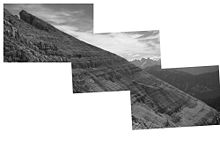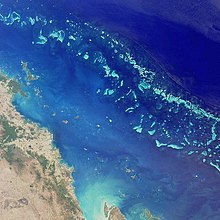Carbonate platform
A carbonate platform is a body of rock deposited in sedimentary form in the sea , which towers above its surroundings and consists of limestone deposits deposited on site.
The growth of the platform is caused by sessile organisms, the skeletons of which build a reef , or by the precipitation of lime from seawater, which is mainly caused by the metabolism of microbes .
Spectacular examples of today's carbonate platforms are the Bahama Banks (several kilometers thick ), the Yucatán Peninsula , the Great Barrier Reef and the atolls of the Maldives . The Florida peninsula is also a carbonate platform, but it is no longer covered by water. All of these reefs are restricted to tropical latitudes . Today's reefs are mainly built up by hard corals , in the geological past other organisms were also involved in the construction of carbonate platforms, such as Tabulata and Rugosa , other cnidarians or archaeocyathids .
Carbonate sedimentation
The mineralogical composition of carbonate platforms is either calcitic or aragonitic . Sea water is oversaturated with calcium carbonate (CaCO 3 ), so that under suitable conditions the precipitation of CaCO 3 is possible. Carbonate precipitation is thermodynamically favored at elevated temperatures and low pressure . If the conditions necessary for precipitation come together, the interlocking of the formation factors sets in motion the production of lime sediment, which can generate enormous amounts of carbonate deposits (“carbonate factory”). Three types of carbonate precipitation are possible: biologically controlled , biologically induced and abiotic .
Biologically controlled carbonate precipitation is the utilization of carbonate dissolved in sea water in the construction of skeletons, for example by corals. Biologically induced carbonate precipitation takes place outside of organisms, so that although the carbonate is not produced directly by the organisms, the precipitation is caused by the activity of their metabolism. Abiotic precipitation is little or not influenced by biological processes.
Biologically controlled carbonate platforms cannot be created everywhere, but only where the living conditions of the reef builders are given. Limiting factors include sunlight, water temperature and the translucence of sea water. For example, carbonate precipitation is widespread on the Atlantic coast of South America , but it does not take place at the mouth of large rivers such as the Amazon , which carry a large amount of suspended matter into the sea.
classification
The three types of carbonate precipitation described above determine different platform geometries. These can be subdivided according to the organisms involved, their sedimentary environment and the type of carbonate precipitation.
Tropical platforms
In these carbonate platforms, carbonate precipitation is biologically controlled, especially from autotrophic organisms such as corals , green algae , foraminifera and mollusks . Tropical carbonate platforms only arise in water that is over 20 ° C warm and well-lit, which has a high oxygen content and a low nutrient and suspended matter content. Such conditions can only be found today between 30 ° north and 30 ° south on both sides of the equator . The tropical type is most common today, but is also often passed down in fossil form .
Cooler water platforms
As the name suggests, these carbonate platforms occur in cooler waters and higher latitudes than the tropical platforms. Carbonate precipitation is biologically controlled by heterotrophic organisms, sometimes in conjunction with photoautotrophic organisms such as red algae . The seawater in which these platforms arise is characterized by a higher proportion of nutrients than in the tropical platforms.
Mud mounds
Mud mounds are characterized by abiotic and biologically induced carbonate precipitation. They grow in nutrient-rich water that is low in oxygen . Mud mounds are best known in the country as fossil formations from the Paleozoic and Mesozoic Era .
Geometry of carbonate platforms
Various factors influence the geometry of a carbonate platform, including the shape of its subsurface, synsedimentary tectonics , ocean currents and winds such as the trade winds . The most important factor, however, is the type of platform itself. Platforms in cooler water generally lead to the creation of ramp-like structures ( carbonate ramps ), tropical platforms are usually surrounded by steep slopes, and mud mounds form hilly bodies with gentle shapes. The tropical platforms have the most articulated geometry. They can be broken down into three main areas: reef, lagoon and reef slope.
reef
The reef is that part of the carbonate platform that is essentially created by the growth of localized organisms. Today's reefs are built up by hermatypical organisms ( living in symbiosis with zooxanthellae ). The reef is the "spine" of the carbonate platform and separates the lagoon from the reef slope. The survival of the platform depends on the existence of the reef, since only this, as a rigid structure, offers protection against waves and wind. Reefs can occur as isolated and largely completely enclosed structures (example: Maldives ), or as epicontinental reef structures lying in front of the continent and connected to it , such as the reefs off Belize and the Florida Keys . From a geological point of view, the reef rocks are massive boundstones , i.e. limestones bound by the corals.
Inner lagoon
The inner lagoon is the part of the carbonate platform behind (inland) the reef. The water depth is shallow and the protection of the reef means the water is generally calm. The sediments of the lagoon consist of the predominant carbonate mud, reef fragments and hard parts of organisms. A proportion of clastic sediments can be added near land . In some lagoons, such as Florida Bay , green algae produce large amounts of carbonate mud. The limestones formed here are classified as mudstones to grainstones according to the Dunham classification , depending on the kinetic energy of the water in the lagoon.
Reef slope
The reef slope is the outer part of tropical platforms, it connects the reef with the ocean basin. A large part of the sediments transported from the lagoon and the reef by various processes is deposited here, including the breaking away of already solidified limestone during storms. For this reason there are coarser sediments in the area of the reef slope than in the lagoon and in the reef. According to Dunham, the rocks on the reef slope are called rudstones or grainstones. Due to the deposition on the slope, the sediments form characteristic arch-shaped or tabular layers , which are already inclined in relation to the surrounding layers during the deposition ( clinoforms ).
Carbonate Platforms in Geological Lore

Carbonate platforms are already known from rocks of the Precambrian , where they were formed by the growth of stromatolites . In the Cambrian , the archaeocyathids were the main formers of carbonate platforms, metazoa similar to sponges . In the Paleozoic , armpods such as Richthofenida and the group of Stromatoporoidea were added as reef formers. With the Tabulata in the Silurian and the Rugosa in the Devonian , corals became important for the formation of carbonate platforms, hard corals only from the Carnian in the Upper Triassic . In the Cretaceous , reefs were also formed by rudists (an extinct order of mussels ).
Carbonate platforms with widespread distribution can be found, for example, in the Devonian and Carboniferous of the Harz Mountains , the Rhenish Slate Mountains and in the south of England and Ireland . In many places the division into lagoon, reef and reef slope can still be proven today, for example in the Attendorner Mulde in the urban area of Attendorn .
One of the best examples of a carbonate platform can be found in the Dolomites . In this region of the Alps , numerous atolls that are still well preserved today , such as at Sella , Gardenaccia , Langkofel or Latemar , formed in the Triassic Sea of Tethys . The carbonate deposition took place over a long period of time on a steadily sinking subsurface. The persistent subsidence led to the accumulation of sediments of considerable thickness. The Northern Limestone Alps , also from the Triassic, form similar sediments .
In the French, Swiss and southern German Jura and Table Jura , as well as in the Swabian and Franconian Alb, thick sediments were deposited on a carbonate platform; the carbonate sediments here come from the Jura .
literature
- JL Wilson: Carbonate Facies in Geologic History. Springer-Verlag, 471 pp., 1975. ISBN 3-540-07236-5
- A. Bosellini: Progradation geometries of carbonate platforms: examples from the Triassic of the Dolomites, northern Italy. Sedimentology, Vol. 31, pp. 1-24, 1984
- PR Pinet: Invitation to Oceanography. West Publishing Company, St. Paul, 1996. ISBN 0-314-06339-0
Web links
Individual evidence
- ^ JL Wilson: Carbonate Facies in Geologic History.
- ^ Bahamas Introduction
- ^ Geologic Map of Florida. About.com
- ↑ Archived copy ( Memento of the original from May 16, 2008 in the Internet Archive ) Info: The archive link was inserted automatically and has not yet been checked. Please check the original and archive link according to the instructions and then remove this notice. Map of the distribution of today's coral reefs. ReefBase
- ↑ G. Carannante, M. Esteban, JD Milliman, L. Simone: Carbonate lithofacies as paleolatitude indicators: problems and limitations. Sedimentary Geology, Vol. 60, pp. 333-346, 1988
- ^ W. Schlager: Carbonate sedimentology and sequence stratigraphy. SEPM, Tulsa, Oklahoma, 200 pp., 2005. ISBN 1-56576-116-2
- ^ Boundstone. EOSC 221, Introduction to Petrology, University of British Columbia ( Memento of the original dated August 22, 2010 in the Internet Archive ) Info: The archive link was inserted automatically and has not yet been checked. Please check the original and archive link according to the instructions and then remove this notice.


